Retail Arbitrage – How to Sell on Amazon for Beginners [With Real Product Examples]
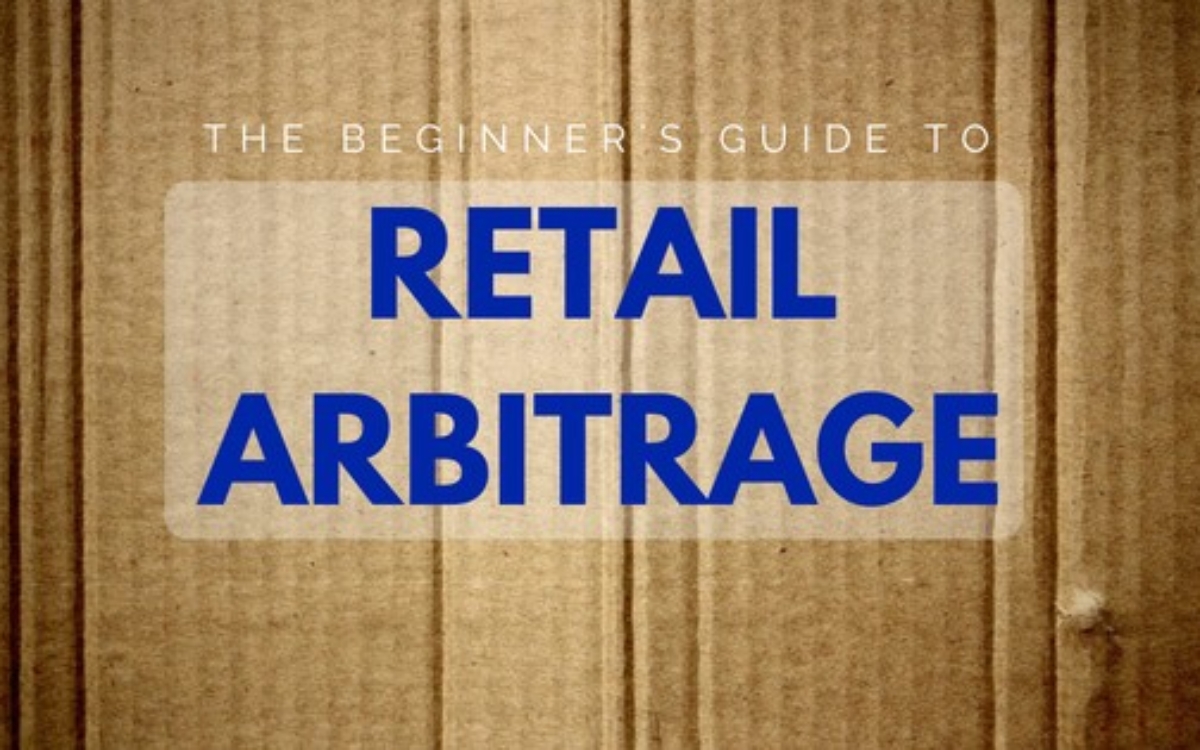
When you buy something through one of the links on our site, we may earn an affiliate commission.
If you are a dedicated reader of Niche Pursuits, you'll know that we talk quite a bit about Spencer's growing Amazon FBA business.
While there are plenty of other FBA sellers doing bigger numbers, I think we can all agree that Spencer's $60,000+ per month in revenue is nothing to sneeze at.
Today, I'm going to take a deep dive into a strategy called “retail arbitrage.” Which I consider to be one of the best ways to start selling on Amazon for beginners.
In addition to just sharing concepts, I'm also going to share actual examples of products I sold on Amazon FBA.
So you can have some ideas of the kinds of things you can sell on Amazon. As well as a blue print for how to start retail arbitrage on Amazon.
What Is Retail Arbitrage?
Retail arbitrage involves finding an item in a brick and mortar retail store or other physical location and then selling it elsewhere. When I resell the item, I've always used Amazon.
This could be finding clothes on the clearance rack, finding an awesome deal on canned foods, or reselling video games (also on a place like CDKeys) for profit.
There's no limit to what you can do here. As long as you buy the items low and sell them high.
Where Are The Best Locations For Retail Arbitrage?
Remember that your money on retail arbitrage is going to be made on the buy. Not on the sale.
If you buy a pack of deodorant for $50, it doesn't matter what you price it at on Amazon. You're going to lose money.
Some places are better at giving these low-priced deals than other places.
Here's a list of my favorite stores to buy items for retail arbitrage:
- Walmart
- Target
- Goodwill
- Salvation Army
- Craigslist
- Dollar General
- Ross
- TJ Maxx
- JC Penny
- Home Depot
- Ace Hardware
- Bargain Hunt
It's worth checking on a discount item in any store you're at.
I LOVE clearance racks, 2-for-1 deals, and pretty well any big discount. Every clearance item is potential profit for arbitrage sellers.
If you use the Scoutify app, you can have a 90% or higher chance of profit on every single sale.
You find a decent profit margin and that means some serious money from reselling.
How To Get Started with Retail Arbitrage
The first step here is to sign up for a seller account with Amazon Once you've got that in place and decide you're going to give this a whirl I'd suggest upgrading to their Pro Seller Account for $39.99 per month.
This gives you access to additional tools and it saves you $1 per transaction in cost, so if you sell 40 or more products in a month it is a no-brainer.
The pro account is also needed to use helpful third party tools like Scoutify from Inventory Lab which I will discuss later down the post.
I'm telling you right no that a scanning app will save you so much time and hassle. When you go hunting for deals at the store you want the right tools.
Here's how it works:
Later I give the example of selling Skyline Chili. If I'm at the store and pick up a 4 pack and scan the barcode with my Scoutify app I'll see this:
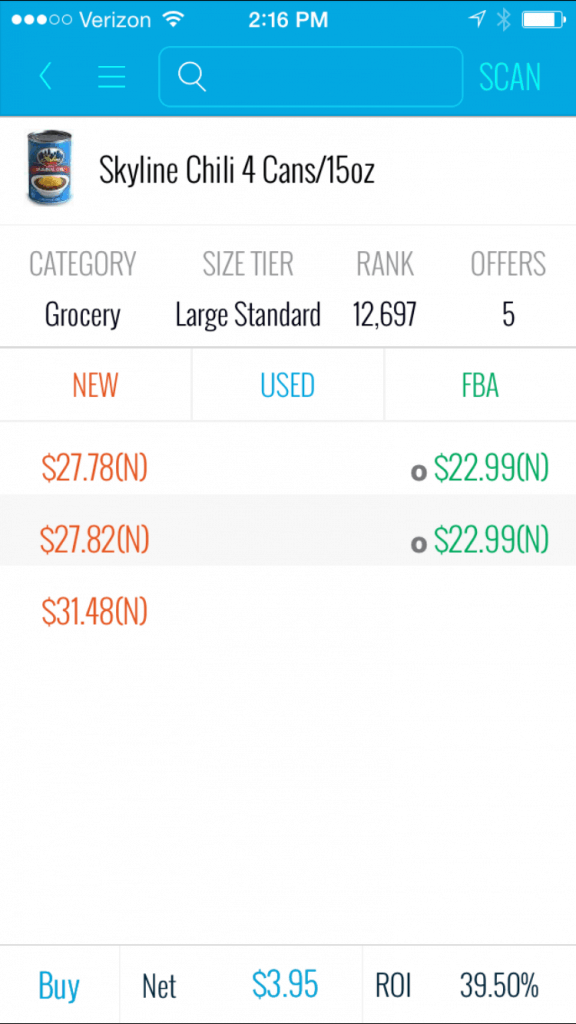
This quickly tells me everything I need to know about whether I should buy this product. Let me break it down for you:
A Note on Sales Rank
While no one knows the exact formula for this, the higher the sales rank indicates that the product has been selling well recently compared to other products in the same category. The rank has been known to fluctuate over time, but here is an excellent chart that gives you an idea of what a good sales rank is in each category.
Based on the chart, I can see that Skyline is likely in the top 15% of grocery items. This is actually stronger than I'd expect.
You can also check the later mentioned CamelCamelCamel (free tool) to track sales rank over time.
Other Sellers: I've found the amount (and type) of other sellers to be extremely important when making a buying decision. The perfect situation is when you have a product with a high sales rank that has zero FBA sellers. Only sellers in the “New” column on Scoutify.
This was the case when I sold the Sharper Image Foot Massagers I discuss later.
For our example above, there are 2 FBA sellers both priced at $22.99 currently that I'd have to compete with.
In some cases, you'll see a small “a” to the left of an FBA price which indicates that Amazon sells the item. If Amazon sells it, do yourself a favor and move on.
Situations like my Ivy and Bean book set are very rare, and you won't often beat Amazon on price.
Another situation I avoid is having a bunch of FBA sellers. Two sellers is no big deal. If you see 5, 6, or even more FBA sellers you better make sure you're getting a really great deal. Otherwise you won't like the profit margins on that product.
What tends to happen is if another seller buys Skyline Chili they'll decide to get cute and price it at $22.95 to undercut the other sellers by .04 in hopes of winning the buy box.
The problem is, thanks to automated repricing tools you'll find that one of your competitors drops to $22.89 within a few minutes. Then another seller will jump down to $22.49, etc.
This little pricing war begins what I call “a race to the bottom” where nobody ends up making any money.
If I did choose to buy the Skyline shown above, I would come in and just match the price of $22.99. The odds are that the other sellers will stay the same. And you'd each get your chances at the buy box.
That means you shouldn't have any issues selling your inventory.
Net Profit: The other key metric on Scoutify is your net profit. This takes the data from Amazon and calculates exactly what your FBA fees are. So all you have to do is tap the amount shown at the bottom and input the price you'd be paying to purchase the item.
Then, you'll see a breakdown like this:
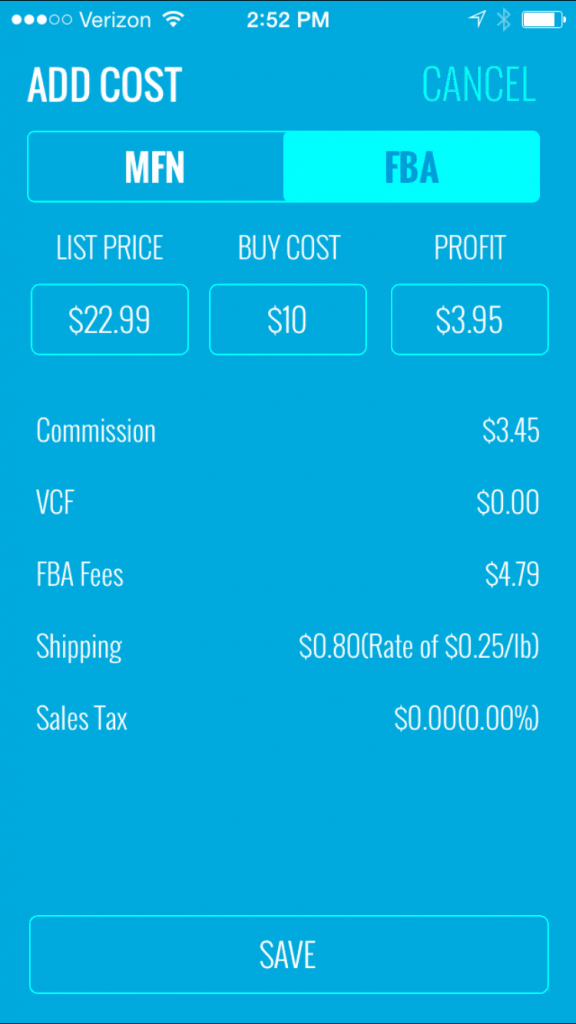
If I were doing this now, making only $3.95 per sale – probably a best case scenario – wouldn't be worth it to me – so I'd keep looking for other products.
Although Amazon would probably never sell the Ivy and Bean set for $9 again, here is how that example would look in Scoutify:
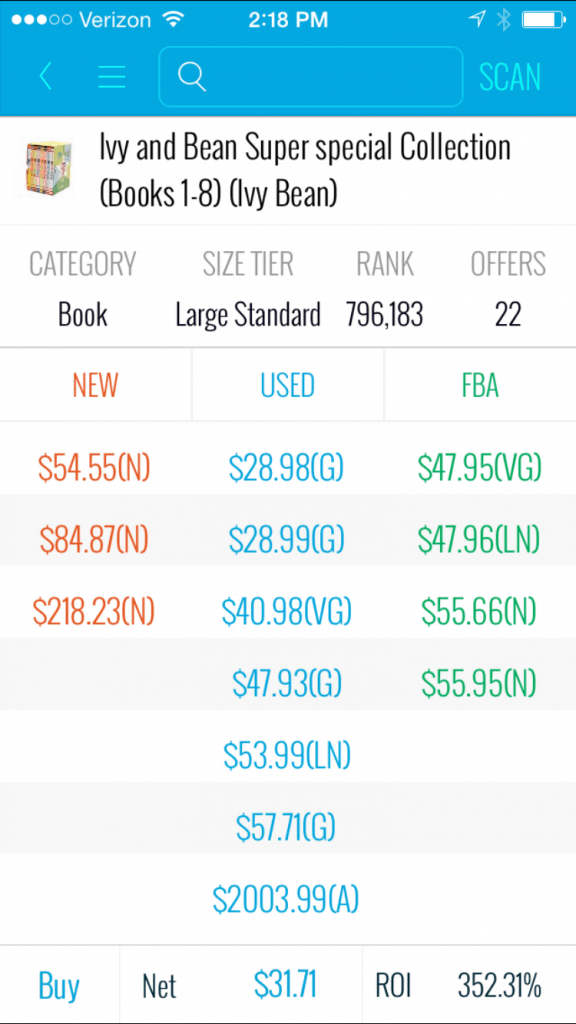
There are only 2 FBA sellers who are selling the product new (indicated by (N)) and they are both third party sellers and priced close to $56. If I bought the set for $9, I would stand to make around $31 profit if I matched their pricing.
Obviously, this would be a deal you should jump all over.
Finding deals like this is at the heart of building a successful retail arbitrage business.
Scoutify is part of the Inventory Lab's suite of products which we use for our Amazon business and highly recommend. Their reporting tools on your sales are WAY better than the reports you get from Amazon.
Click here to do a 30 day free trial of Inventory Lab (which includes the Scoutify app)
Reselling On Amazon FBA
Now that you have your inventory, it's time to sell that stuff on Amazon FBA. There are a couple of ways to do this.
You can keep your products at your house and send them to each seller every time you get an order.
This is doable and you save a little bit of money, but I don't recommend doing it.
I think it's much wiser (and easier, and more scalable) to send your products to an Amazon FBA facility. You'll lose a bit of cash to Amazon's fees.
But they take care of all storage, shipping, and even a bit of the return process.
This opens up an amazing number of possibilities to scale up with your online arbitrage efforts.
Let's face it: you only have so much time. And Amazon's warehouse is almost certainly larger than your garage or storage!
Amazon will give you instructions to send your products within Seller Central. They receive it at their warehouse, store it, send it to the buyer, and give you the money.
It's a lot easier to do and helps you to maximize your sales over the long run.
My Journey With FBA
In 2012-13 I was working full-time. As I often did I was looking for ways to make extra money on the side. I already did some of my shopping on Amazon. But I wasn't really aware of their FBA program and what it actually meant.
By researching a bit I discovered that I could find products at local stores, send them into Amazon's warehouse, and then sell them on Amazon's site for a profit. I actually had some success with this and made a few thousand extra dollars doing it.
Fast forward to today and I'm now spending much of my time managing an Amazon business. I've learned quite a bit about coming up with product ideas, finding manufacturers, getting samples, and ultimately launching products on Amazon.
In addition, I've got several of my own products selling on Amazon which is quickly turning into a nice side business for myself.
I'll admit that the entire process of launching a brand new product from scratch sounds simple on paper. But there is actually a lot to it.
Fortunately, my experience with dabbling in retail arbitrage really gave me a head start on understanding the process of selling goods on Amazon.
This has ultimately allowed me to take the next step. Which is to create brand new products/brands to sell.
If you're still on the fence or just starting out, hopefully this retail arbitrage on Amazon for beginners guide will help you get rolling.
Understanding The Basics
Already I've thrown around some terms that you may not be familiar with. Especially if you are truly brand new to selling on Amazon.
So let me take a moment to explain some basic concepts:
FBA – “FBA” is an acronym meaning “fulfilled by Amazon.” In practical terms, this means that when you have a product to sell, you send it into an Amazon fulfillment center and they will store it and ship it for you when a customer buys it.
You don't have to sell “FBA” to sell on Amazon, but there are some clear advantages to doing it this way which I'll discuss in a moment.
Retail Arbitrage – This is all about discovering and profiting from inefficiencies in the market. For example, if my local Target has a box of teeth whitening strips selling for $10 on clearance, and that same time that product is selling on Amazon for $30 . I can buy it at $10 and sell it for $30 on Amazon.
The difference between those 2 numbers is my profit margin.
Why Would Anyone Pay That Much?
Let's pause for a moment and help out that skeptical voice you may have on the inside saying “This sounds too good to be true.“
One of the first questions you probably had when you read my example of retail arbitrage is: “Why would anyone pay $30 for something they could buy at Target for $10?“
It's a fair question. But this is really what a market inefficiency is all about.
Here are a few reasons why people would (and do) pay more to buy on Amazon in certain situations.
Prices/Deals Vary by Location
Just because a product is slow moving in a Target store in Ohio doesn't mean that someone in Oklahoma wouldn't be happy to pay full retail price for that same item on Amazon.
Regional price differences can open up major Amazon arbitrage opportunities.
People Pay for Convenience
There is a reason Amazon does billions in annual revenue. People like buying stuff from Amazon because it's fast and convenient. It is the default option for buying goods online.
Some people would rather pay more and get it on Amazon. That way there's no driving across town, standing in line, wasting gas, etc.
And that's assuming they even have a Target nearby to shop from in the first place.
All Products aren't Available Everywhere
When you go on vacation and visit a Kroger store, you'll probably notice a bunch of brands of barbecue sauce, snacks, and other items that you've never seen in your local Kroger.
That's because selection varies regionally. Which means that someone who loves a product only sold in New York might be out of luck if they live in Nevada.
There are a bunch of limited availability/regional products sold on Amazon. They often sell at a premium higher price because of this scarcity.
Benefits of Selling FBA
While Amazon sells plenty of products on its own, third party sellers make up a big (and growing) chunk of their sales.
Third party sellers sell many billions of items on Amazon's platform yearly. This is a major percentage of total sales.
As a third party seller, you can really sell in 2 different ways:
- Via FBA
- By fulfilling orders yourself
In other words, you keep the inventory at your house or business and when sales come in you would ship out the orders to the customer.
If the possibility going to the post office multiple times per day wasn't enough to convince you that FBA is the way to go, then consider a couple other reasons that selling FBA is a much better choice:
Amazon Prime Benefits
When you sell fulfilled by Amazon, the buyer can benefit from fast, free shipping with Amazon Prime. This is HUGE.
Over 120 million of Amazon's US customers are Prime Members according to this digitalcommerce360 article, a number which will only continue to climb based on the trends of many many years at this point.
According to Quartz, those Prime members spend $1,200 per year on average, compared to only $500 for a non-prime customer.
So by using FBA, you are tapping into Amazon's largest and best customer base.
These customers will enjoy free two-day shipping. Or in some cases be eligible for free next day shipping on YOUR products, depending on where they live.
In my experience, customers will absolutely pay more to buy from an FBA seller than they would to buy from a third party seller who ships their own orders.
If they already pay for Prime, they trust that Amazon will deliver the item fast (and free) which means that they might pay $49 to get the item with Prime shipping instead of buying the same item from Al's Toy Barn (Toy Story reference) who is priced at $30 + $8 for shipping.
I'll share an example in a moment of how I tested the limits of just how much people are willing to pay to get an item from an FBA seller.
Cost Savings
In addition to the fact that you can typically charge more for your product when selling FBA, I also believe you can save money in the end.
Let's say you go buy 25 items that you are planning to sell on Amazon. As a third party seller fulfilling your own orders, you'll have to ship out all 25 as they sell.
Which might mean:
- Packing up 25 different boxes.
- Printing 25 shipping labels.
- Loading boxes into the car.
- Then 25 trips to the post office
- Not to mention all the time involved to check those orders, prep them, etc.
With FBA, you'll get home from the store and go into Seller Central on Amazon and say that you want them to provide the shipping and customer service for your order via FBA. They'll tell you which fulfillment center(s) to ship it to.
Then you make just one trip to the UPS store or get a pick-up service and ship all the goods at once.
Then, as items sell, Amazon ships them to the customer. You just get an email letting you know that they've shipped an item you sold.
Yes, you pay additional fees for pick/pack and storage for Amazon to do that service.
But I've always felt they are very reasonable and factoring in the cost of buying your own materials and the value of your time to fulfill your own orders.
I believe you save money as a retail arbitrage business with FBA in the end.
You Can Sell More
My wife hates clutter. When I used to sell stuff on eBay I had products laying around everywhere. It was taking up space and causing stress in my home.
As a result, I would consciously buy less stuff because I really didn't have room to store it. Or I didn't want to hear about having 200 unopened board games sitting in my dining room!
Amazon FBA makes space a non-issue, allowing you to scale.
Now if you find a killer deal – go ahead and buy every unit in the store.
You can simply run home, find out where Amazon wants you to ship it, and then have your inventory boxed up and out of the house before bedtime.
No Customer Service
Another benefit of FBA is that Amazon handles the customer service after the sale. In particular, when a customer wants to return an item they can do that by sending it back to Amazon.
Occasionally customers will contact you directly.
But not having to deal with questions about tracking numbers, delivery schedules, and even the refunds that come with a return is a huge win.
What to Sell on Amazon FBA
You can sell almost anything on Amazon. There are a few restricted products/categories for FBA, but generally it's reserved for things that are potentially hazardous, insanely huge (like over 150 lbs), or in a category ripe for counterfeits like beauty/clothing where you'd have to put in a special application to sell those products.
I've sold pre-packaged food, coffee, toys, novelty items, home goods, cleaning supplies (sponges, etc.), teeth whitening strips, and more.
While some people sell used books, I've always focused on selling brand new items that you can buy at a discount and then sell for retail price on Amazon.
Really the only question I care about is “Can I sell this and make a profit?”
If the answer is “yes” then I'll buy it and send it in. As far as margins go, I heard a good rule of thumb for retail arbitrage from Chris Green who literally wrote the book on Retail Arbitrage that a simple way to think about it is the rule of 1/3.
You can roughly figure that the cost you are paying should be about 1/3 of what you can sell it for on Amazon. Then Amazon will get roughly a third in fees, and you'll keep a third.
So like an earlier example, if I'm buying some teeth whitening kit for $10, I'd like to see it's selling for $30 on Amazon.
Obviously there are plenty of variables that go into these numbers. For instance, the heavier and bigger an item is the more it will cost to ship to Amazon and the more you'll pay in FBA fees.
So the best way to get accurate projections is using a tool like Scoutify from Inventory Labs. I showed you how it works a little earlier in this post.
But basically it's an app for your phone that you can scan an item in the store and quickly see how much it sells for on Amazon and what your projected profit will be.
Real Examples
I'm pretty much out of the arbitrage game now that I've started creating and selling my own branded products on Amazon. So I'm happy to share some real examples with you of things I actually found and sold for a profit via Amazon FBA.
The very first thing I sold on Amazon was a box of Starbucks K-cup Coffee. I found it at Sam's Club for $36 and at the time it was selling for around $55 on Amazon.
Although those margins aren't very good at all, the sales rank was up around 2,000 which means that it sells like crazy. So I bought a few boxes, sent them into Amazon and profited about $5 per box.
On that same trip to Sam's Club, I found another interesting product which was a “one time buy” AKA not something they have in the store all the time.
It was this Sharper Image Foot Massager. At the time it was selling for $48 at Sam's and on Amazon it was only sold by non-FBA third party sellers, with the lowest price being around $80.
I bought a couple of them and priced it at $84. But because I was the only Prime seller, I quickly sold both units and netted just over $10 per sale.
Going Big
Now that I had a taste of success and made about $50 profit on my first trip to Sam's, I went a little crazy. I went back with credit card in hand and bought every Sharper Image Foot Massager they had left.
My total was right at $1,000 for 20 massagers. I filled our SUV to the brim, bought some big boxes at Walmart and shipped them all into Amazon.
This time, I started testing the theory that people would pay more to buy from an FBA seller.
Rather than pricing at $84, I jumped it up to $99.
Much to my surprise, I still had the buy box (meaning I was the default seller when someone clicks the buy button) and I kept selling them pretty quickly. Even though there were still other non-FBA sellers who were priced at $80.
Even though I was making $25 profit at $99, I ended up jumping my price again when I was nearly sold out to $119, and sold the last few units at that price. A full $40 more than they could have paid for the exact same, brand new item from a non-FBA seller.
That's the power of FBA in the online arbitrage world.
In the end, I made about $450 profit on my $1,000 spent.
But to really make the most of these opportunities, you'll want to use tools. Check out our comparison of Tactical Arbitrage vs Oaxray for ideas on how they can help.
Going Local
Earlier when I was answering the common question from a skeptic “Why would anyone pay that much?” I mentioned that one reason is because not everyone has access to the same products at their local stores.
If you want something and you can't find it locally, you'll probably go Google search that item. When you do, you'll probably find an Amazon product listing sitting right at the top of the results.
Since Amazon has a high amount of trust, many people won't bother clicking elsewhere. They just go to Amazon and confidently buy what they want.
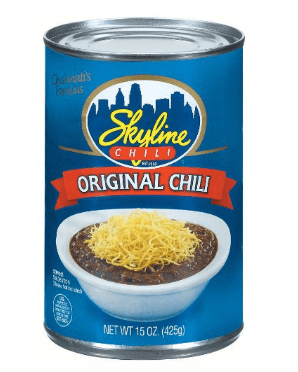
One example is Skyline Chili which is the thing that everybody tries when they visit Cincinnati.
For those that love it, the odds are they are out of luck on buying more when they get back home.
Unless they buy it online.
I used to buy packs of 4 cans of Skyline for around $10. At the time they were selling for about $28 on Amazon. Which was a consistent $7 – $8 in profit per sale.
Another notable local place is Montgomery Inn, famous for their ribs and barbecue sauce. I used to buy this 2 pack of sauce from Sam's for around $5. Then turn around and sell it in the high teens on Amazon.
Another example of a place that has national demand with limited local availability is Trader Joe's brand products. The small grocery chain has a cult-like following and they don't sell their products online.
Look on Amazon and you'll find plenty of people willing to sell you Trader Joe's products at a mark up.
Perhaps some might frown on this practice.
But the reality is that if someone really loves Trader Joe's shampoo which sells for $5 in the store but their closest store is 200 miles away, they might decide to pay $15 for a bottle of it and have it delivered to their doorstep.
Here are examples of Trader Joe's products that sell on Amazon.
Depending on where you live, you may have similar products that have a wider demand than they do distribution. If so, the odds are that many people who would buy that product but can't.
Those people are turning to Amazon to try and find it.
If the numbers work, it might be a great way to break into retail arbitrage.
Going Online
While there is no magical store out there to find the best deals, some of the places I frequented were Sam's, Target, Big Lots, TJ Maxx (for toys), and then just any other random big box store I'd find myself in and spot a suspiciously good deal.
If it sounded like a good deal, I'd pull out a scanning app like Scoutify and see how much the product sells for on Amazon.
While most of the things I sold were found in a local store, I did find some deals online that I was able to buy and turn around on Amazon for a profit.
In fact, one of my favorite stories was a box set of books that I actually bought from Amazon and then sent them back in to sell on Amazon as a third party seller.
What?!
Yes, I was a frequent visitor of DealNews.com which is a deal finder/curator that highlights big sales on products. They showed a deal for an Ivy and Bean box set that was normally $99 selling for only $9 from Amazon.
I used the CamelCamelCamel price tracking tool to verify that the price really had been $99. Plus I saw that all the individual books in the set were selling quite well, too.
I ordered 25 sets of books, and got them from Amazon 2 days later. I opened them and did the required FBA labeling. Then I shipped them right back to Amazon in the same boxes they had arrived in.
As suspected, Amazon raised their price back to $99. So I ended up selling my sets for $49. Because it's really hard to compete head to head with Amazon when they sell a product, too.
It took several months, but I sold all 25 sets and made over $25 profit per set.
Going On Amazon
Another really cool way to make easy profits is flipping used textbooks via Amazon's trade-in program. The biggest difference between this and what I just shared about the kids book set is that with textbook arbitrage you know ahead of time how much profit you'll make.
How's that possible?
There are tons of individual sellers listing used textbooks on Amazon. Some at really low prices.
Many times you can buy that cheap textbook and then turnaround and trade it into Amazon for a much larger amount. Since Amazon lists their trade-in price, there's a actually a pretty cool hack for finding these kinds of deals very quickly.
FBAMaster has a tool called TexTrader that searches Amazon for you and lists all the profitable textbook deals. It's pretty slick – click here to see how it works.
Can I Lose Money Doing This?
Yes.
Like anything else you do, there is risk involved.
However, the thing I love about selling on Amazon is that you don't have to worry about driving traffic the stuff you're selling because Amazon is just a monster.
If people are looking for the product you're selling online, there is a pretty good chance they'll end up on Amazon's site at some point. Which gives you a really solid opportunity to make money selling things there.
If you're still a little worried about getting started, let me leave you with a few tips on how to not go bankrupt selling on Amazon:
Avoid Overly Competitive Products
To be safe, if Amazon sells the product too – don't buy it. If there are 5 or more FBA sellers and your margins are tight – don't buy it.
While sometimes the race to the bottom is unavoidable, I'd encourage you not to be the one who starts it.
Just match the lowest FBA price and exert a little bit of patience and you'll sell through.
Avoid Big and Heavy Products
Set your mental filter to look for things that are small and light when you are scouting deals.
If you find some weight bench for $25 and it sells for $75 on Amazon, that's probably a bad deal. You'll pay so much to get it there and then so much in FBA fees that your profits will quickly disappear.
It's also more expensive to store big items, so the longer it sits the less you make.
Go Big or Go Home
When you're first starting out, you tend to be a dabbler. “This is a great deal so I'll buy 2 of them, 3 of these, and then 1 of this other product.”
While that's ok at first, once you've made some sales and have a little confidence then you should really start going big when you find the best, no-brainer deals.
If you find some crazy sale at Big Lots on a product that sells well on Amazon and the margins are there, drive to every Big Lots in town and buy all their inventory.
You might get some odd looks, but who cares? You have a burgeoning retail arbitrage business to run!
Create Bundles
Did you know that you can add new products to Amazon? At some point, it may make sense to buy a couple of related products, like a candle and a diffuser, and package them as a new product. Here's a helpful article on how to do that.
Even if you don't create bundles new, look for listings of products that feature different quantities. For example, the Montgomery Inn barbecue sauce I sold got very competitive for the 2 pack.
However, there weren't nearly as many sellers selling the 6 pack. So I would buy 2 packs at the store and use shrink wrap to turn them into a 6 pack. This left me with better margins and less competition.
Honestly, the best thing you can do is just get started.
Set up a seller account, do a free trial of a scanning app like Scoutify and go to the store.
Most people won't get rich doing retail arbitrage, but it is a fun, legitimate way to make a meaningful amount of extra money.
Looking For More?
If you're thirsty more more information about retail arbitrage and FBA selling in general, here are some great resources to check out.
Nick Loper's First Shopping Trip – Nick of Side Hustle Nation shares his experience using a scouting app, searching for deals, and making his first sales on Amazon.
CamelCamelCamel – Although I hate the name of it, make sure to bookmark this site. If you're feeling gun shy, their historical data on prices and sales rank are super helpful.
Inventory Lab – I gave a demonstration of their Scoutify app, but if you are really diving in to selling on Amazon then I highly recommend checking out the entire suite of solutions at Inventory Lab.
SellerEngine Blog – SellerEngine also sells Amazon tools like a scanning app and a repricing tool, but they also have a really helpful blog worth reading that covers many topics to help you succeed.
Spencer's FBA Business – Once you've mastered retail arbitrage, the logical next step is to look into creating your own products and selling them FBA. If you are the creator and the manufacturer of a product, you don't have to worry about pricing wars with competitors.
TexTrader Chrome Extension– Quickly finds textbooks on Amazon that you can buy from 3rd party sellers and then trade in to Amazon for a profit.
Online Arbitrage – Read this complete guide on how to get started with online arbitrage (similar, but different, than retail arbitrage).
We also have an additional guide on how to make money on Amazon in ways outside of retail arbitrage.
As I stated at the outset – I'm not the foremost expert on Amazon FBA. But I've had enough experience to be dangerous. If you've got any questions or tips of your own, please share in the comments below.
Want to learn step-by-step how I built my Niche Site Empire up to a full-time income?
Yes! I Love to Learn
Learn How I Built My Niche Site Empire to a Full-time Income
- How to Pick the Right Keywords at the START, and avoid the losers
- How to Scale and Outsource 90% of the Work, Allowing Your Empire to GROW Without You
- How to Build a Site That Gets REAL TRAFFIC FROM GOOGLE (every. single. day.)
- Subscribe to the Niche Pursuits Newsletter delivered with value 3X per week
My top recommendations
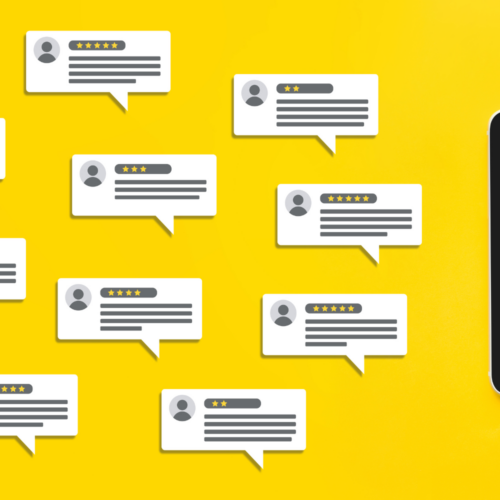
















22 Comments
Conversation
Great post.
Everytime I read a post like this, I get inspired, go to amazon.in but to my display they ask you for your business registration number which is a time and money consuming process. Does amazon in US also require you to have a registered business or can anyone register as a seller like one does as a customer ?
Hmmm – In the US that is/was not the case for me. I used my own SSN as opposed to a business tax ID when signing up to sell as an individual.
Hey Jake, thanks for the great article. I have a question about selling in the states. I live in Canada and the market is pretty small here. Do you know any resources that show you how to sell internationally?
Hi Isaac – I don’t have anything offhand to point you too, but I know we now sell some of our products into overseas markets – we just had to ship our inventory to those fulfillment centers. Maybe you could do the same and sell in the US market.
However, that would probably only make financial sense if you were doing your own branded products and might really cut into your margins if you were just thinking retail arbitrage.
Didnt amazon announce this week they eliminating sellers that arent authorized resellers and requiring many sellers that are doing retail arb to remove their inventory from fba?
Hey Brian – I hadn’t heard that, do you have a link to where you saw that? My initial thought is that you’re selling the actual product in the listing, like a 4-pack of Skyline Chili from my example, I don’t know how/why they would stop you.
they started doing it for big brands so independent sellers who were doing retail ARB are impacted. Sellers have been notified by Amazon to remove brands even if they legitimately bought them or having pay large fee to sell the brands. Supposed to happen more
http://www.cnbc.com/2016/08/29/amazons-plan-to-fight-counterfeiters-will-cost-legit-sellers-a-ton.html
Got it – yeah it sounds like right now it’s limited to very big brands and my guess is that it’d be a long time before they could practically enforce that for every brand of product on Amazon, so I don’t think retail arbitrage is going anywhere anytime soon. That said… I do think retail arbitrage should be a stepping stone to selling your own brands of products because that is much more scalable IMHO.
What about collecting taxes? I understand that with FBA you don’t know which states your merchandise is being warehoused in, and since warehousing product counts as nexus, you’re on the hook to collect those taxes.
Hi Dennis – that’s a very complicated issue with many different opinions. The best resource I’ve found for state by state information is Taxjar.com if you’re doing research on it.
Hi Jake,I can’t do RA in Australia as we do not have amazon warehouses.Any thoughts on Online Arbitrage and mentors.Cheers Brian.
Hi Spencer.
There is a way to make retail arbitration from outside USA?
Thank you
Hi Jake,l am inspired by this technique and would have love to get my feet wet with is greate idea. But l reside in Ghana where Amazon doesn’t ship to.
How do l apply this principle in a third world country in my case Ghana where online shopping is now sprouting.
I an jobless now and need to get into this internet entreprenueship. Are there any resources that can help me. Thanks
Very inspiring for beginner guide to sell on amazon.
Thanks for sharing this and keep up the good work.
I see several are asking about the possibility of doing this internationally. I’ll be honest that my experience was only living and selling in the USA – so I don’t have much concrete info to give you. I’d say to check out Amazon in your country and see if they offer FBA services to individual sellers. If so, there may be a chance to do it where you live. If not, you’re probably out of luck with this particular strategy.
hi, can I do FBA if I am from Philippines
Thanks for the information Jake. However I have run into a problem on Amazon. When you are trying to list certain products especially ones like “grocery & gourment foods” they ask you for invoices in order to get approved. If buying them from a store like Big Lots or even Trader Joes. What are you submitting to get approved?
Thomas – interesting, I found this list of known restricted brands based on user experience: http://thesellingfamily.com/the-known-brands-that-are-not-allowed-to-be-sold-by-amazon-third-party-sellers/ – I never sold anything that I had to get approval for, so if it’s making you show some approval for Trader Joe’s especially, that would be new since I was selling it FBA. If Trader Joe’s is out, the principle of selling regional brands would still hold true if there are any you can take advantage of.
Hey Jake,
Thanks for the reply. Actually its by category that they are doing it, nothing to do with Trader Joe’s even if you just try to do coconut oil you will have that issue. If I try to sell books, toys or something I have no problem just listing the items. However for Beauty, Grocery & Gourmet foods etc they require invoices. If I find a way around it I will let you guys know. Thanks for the link as well. And
Thanks @Jake for writing this epic post. I love the real examples that you have provided in this tutorial. Really, learned too many things. Now I can say that I can sell products on Amazon. Thank You.
I have sold a little on ebay. This sounds way easier!
I have sold a little on ebay. This sounds way easier!!